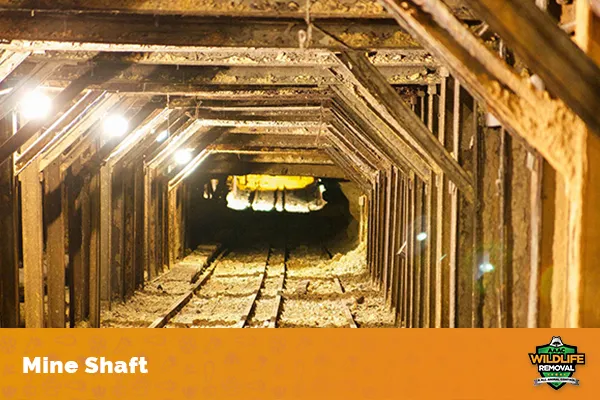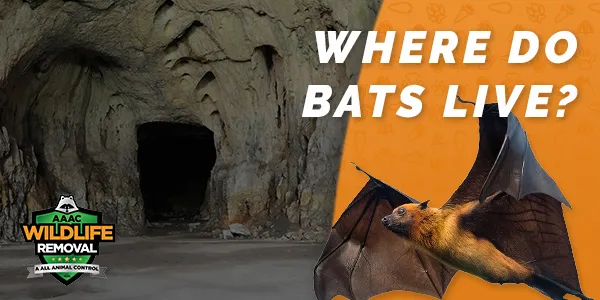Bats live all over the world and their roosting sites vary depending on where they are. From their natural habitats like rainforests and caves, to man-made roosting sites like inside barns and attics, bats can be found all over. Bats can usually be found near water sources as well as deserts or tropical forests which means that there is no one specific place for them to live across the globe. They often make use of roosts but also hibernate during winter months – this period lasts about six months before it starts again with warming temperatures and increased bug populations. In this article, we will discuss bat habitats and more!
Where do bats live?
Bats have an almost enigmatic and mysterious quality to them. They are nocturnal flying mammals with a large wingspan and pointed ears. But you might have always wondered “Where do bats live?!” There are around 1400 species of bats in the world today. Some live in trees while others find their homes in caves or underground locations like mineshafts and wells. Some even used buildings as shelter.
Where do most bats live?
Most species of bats typically reside near water sources such as rivers, lakes, streams, and ponds where they can hunt after dark. They will use these areas until prey populations die down before looking elsewhere for food resources; this helps maintain healthy forests by keeping harmful insect populations in check. Bats can be found everywhere! from their natural habitats like jungles and rainforests to suburban communities and city parks. They don’t thrive in the cold so they prefer secluded places with consistent temperatures to get them through winter hibernation.
Where are bats from?
Bats belong to an order of mammals called Chiroptera which means ‘hand-wing’. There are over 1400 different species that exist worldwide and about 30% of them live in Central or South America where the climate is warmer and they have plenty of insects to eat.

Where can you find bats in the summer?
In summer, they can be mostly found in tall trees or high up on the side of buildings. They love to find cracks and crevices that are high off the ground because it makes it easier for them to swoop down, catch their prey then fly away!
Where can bats be found in the winter?
In cold climates, bats will find roost sites with the most optimal temperature for hibernation. Somewhere they can form colonies and stay warm like caves, rock faces, and tree cavities where they can hibernate and survive with their fat reserve. Most bat species require a temperature of at least 5 – 11 C (40 – 50 F) while a big brown bat can tolerate lower temperatures ranging from 0 – 5 C (30 – 40 F).
Natural habitat

Caves
Caves are the most popular roosting site for bats. Hibernating bats like caves because they are dark, secluded and provide the perfect protection from the elements as they hang out upside-down. The Bracken cave just outside San Antonio, Texas has as many as 20 million bats inside it! It is the world’s largest colony of Mexican free-tailed bats!

Trees
According to Bat Conservation International, more than half of the 47 species of bats that live in the U.S. roost in trees. Trees are one of a bat’s natural habitats. They provide plenty of food, protection from predators below them, and a nice secluded spot to stay warm on cold nights. In warmer climates, roosts can be found in tree hollows or branches of trees like palm leaves, olive trees, and other fruit-bearing plants.
Some species like to live in old hollow trees as it provides shelter from the wind, rain, and snow while also offering an easy escape route should there be any danger lurking outside. Others live in the foliage of trees and some roost beneath the loose bark of dying trees. There are also those who prefer to hide up high in leafy canopy tops. The species that like to live in trees are the Eastern pipistrelle, Northern long-eared bat, the endangered Indiana bat, small-footed bat, silver-haired bat, red bat, hoary bat, and the Seminole bat.

Rock crevices
Crevices and gaps on rock faces as well as other bat-friendly rock structures make for great shelter. Like caves, bats prefer these as they provide the perfect refuge from predators and also because it offers protection against elements like rain, snow, and wind. Some of these roosts can be found in limestone caves or abandoned mines.
Man-made structures
Bats often find themselves roosting inside man-made structures like abandoned mines, barns, buildings, tunnels, old wells, and sometimes, inside your attic. Many species find the environment perfect for creating maternity colonies (during bat roosting season) and rearing young bat pups as the temperature is stable and there is plenty of space for different species. These structures are the roosting site of choice of big brown bats and vampire bats.
Wells
Water sources such as wells provide excellent roosting sites for bats. Around these, bats can easily find insects to feed on. Water is an excellent place for insects to reproduce, so a hungry bat can do far worse than a well for their choice of lodging.

Mine Shafts
Mines also offer protection from the elements and predators as they are usually dark and damp – a perfect environment for hibernation. Bats like dark spaces that are easy for them to get into and out of which is why they often live underground or under forests where there’s an opening at ground level. The entrance will usually lead down through a tunnel system until it reaches deeper parts of the cave where they will find their perfect roosting site – away from predators or any chance encounters with other animals.
Buildings & Attics
Bats love living inside abandoned houses or in attics where there is little light during daytime hours. Attics or basements usually have plenty of nooks and crannies for them to hang out in and are dark enough that they can sleep in the daytime. They will live in old attics, barns, and warehouses- any dark place really. They even find spots on church rafters quite frequently! These places offer safety during cold weather months. If you need bats removed from your attic, consider speaking with a wildlife expert at AAAC Wildlife Removal!
Under bridges
Bridges are often another location that bats like to roost at as it provides shelter and natural shade that protects them from the elements while also keeping them close to nourishment sources – insects! It’s not uncommon for some species such as the Eastern Pipistrelle or Brazilian free-tailed bat, to live under them. They know that these will provide protection so it is always a popular spot for bat colonies.
The congress avenue bridge in Austin, Texas is a great example of a bridge that has become a popular roosting spot for bats. It is home to the largest urban bat colony in the world. The population of Mexican free-tailed bats living under this bridge is estimated to be close to one million and counting!
Bat house
A bat house is not only one of the best bat habitats, but it also provides an opportunity for humans to control mosquitoes and other insects on their property. It is usually a wooden box with an opening at one end where bats fly in to roost. Putting up a bat house can be beneficial to both the environment and your backyard.
Where do bats live during the day?
During the daytime, they can usually be found in dark places like caves, old buildings, attics, and mineshafts. Bats are nocturnal animals so they sleep during the daytime and come out to hunt at night. They don’t have very good eyesight so they mostly rely on echolocation and their sense of smell to find prey.
FAQs
Do bats make nests?
No. Unlike birds, bats don’t make nests. They use colonies to keep warm and to care for their young.
What do bats eat?
Bats mostly feed on insects such as mosquitoes, beetles, and even moths to provide them with energy. Some eat fruits such as bananas and mangoes and others, like the vampire bats, feed on blood.
How many types of bat species are there?
There are over 1400 different species of bat which is a pretty huge number when you think about it! Most people know that vampire bats exist but other common ones include fruitbats, rhinolophids, megabats, and horseshoe bats.
Do bats like living in attics?
Bats love finding homes inside dark places where there is little light during daytime hours – like old attics or basements, barns, and warehouses! These locations offer safety during cold weather months when it’s difficult for them to forage. The attic provides the perfect roosting site, especially for females. If you find bats in your attic, you might consider bat abatement, or a quick guide on cleaning bat poop in the attic.
Are bats endangered?
Bat populations in the world are decreasing due to habitat loss and the fungal disease called white-nose syndrome. They are endangered and it is important to take steps in protecting bats and their habitats. Laws like the “Endangered Species Act” have been enacted in order to provide protection.
Originally published on https://aaacwildliferemoval.com/blog/bats/where-do-bats-live




